Caracol: The Largest Mayan Ruin in Belize
One unavoidable part of travel is the ever-present salesmen and women hawking their touristy goods and guided tours. As seasoned globe trekkers, we are pretty good at quickly moving forward without too much haggle annoyance. However, there are times that avoiding the paid tours can be more of a hassle. A recent visit to the remote ancient Maya ruins of Caracol in Belize is one of them.
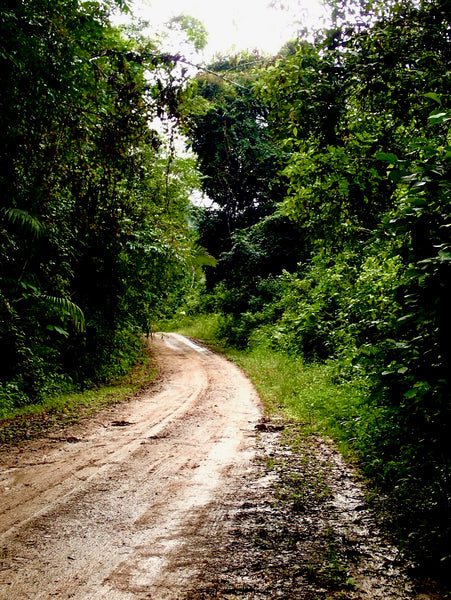
A long remote ride into the jungle far from town.
Caracol is the Spanish word for snail. The name was given to the site by an early explorer for the abundance of snail shells found in the area. The ruins are situated in the foothills of the Maya Mountains in the western Cayo District of Belize. The road, mostly unpaved, leads several hours deep into the jungle through mountains, a pine ridge forest, across rivers and arrives at a military checkpoint to enter the forest reserve that surrounds the important Classic Maya center of Caracol. The ancient site is located a few jungle covered miles from the Guatemalan border and 50 miles from the nearest town of San Ignacio. The region is remote today, however, in the 6th century Caracol rivaled the famous Tikal establishing regional dominance for a period of several hundred years.

Caracol is Spanish for "snail." The shells are found throughout the archeological site.
Arriving in the rainy season, Cody and I rented a Honda CRV with high ground clearance with the hope of exploring some jungle back roads. The next day, we discovered an off-road tour to the ancient Maya site of Caracol. We grabbed the brochure and planned our trip. The tour groups left at 9:30 a.m. and we decided to wait an hour to prevent following along the road together.

The road to Caracol. Watch out for rain and make sure to let someone know where you are going.
The first 10 miles are along a poorly paved street that gives way to sandy dirt. After a few short minutes of bumpy discomfort, Cody increased the speed for a smoother ride. In under an hour, we arrived at the entrance to Chiquibul Forest Reserve. We approached the gate prepared to pay an entrance fee. The man in a military uniform asked why we were not with the group? I immediately grabbed my press pass explaining I am writer and working on a story about Caracol. He called someone on his walky talky. Cody and I waited looking at each other confused. The military man explained that we needed an escort to pass through the reserve. I reiterated that I am working on a story, adding, we missed the group and we’re trying to catch up. (I know, but it worked.) He let us pass.
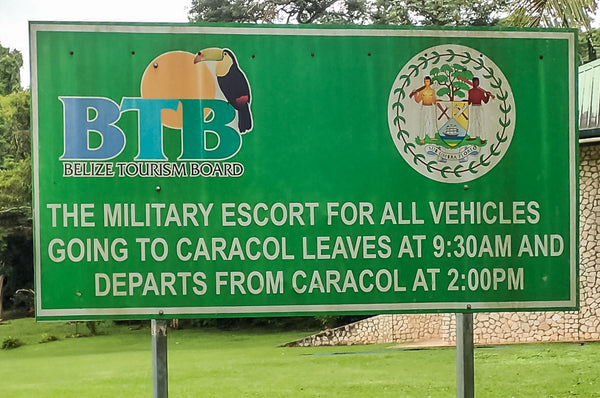
Make sure to book a guided tour or you may not be allowed access.
Caracol is one of the least visited Maya sites in Central America. First reported by a native logger named Rosa Mai, in 1937, the remote location took archeologists 2 days to reach and required packing in all equipment and food. Excavations were too costly but several surveys revealed many carved monuments and limited notes about the structures. Beginning in 1985, Drs. Arlens and Diane Chase with the Caracol Archeological Project have conducted yearly field excavations contributing to the comprehension of the site’s importance among the ancient Maya. Finally in the year 2000, the Belize government invested money and resources to develop the site for tourism. The project was headed by Belize archeologist, Dr. Jaime Awe, and included 100 workers for 376 days uncovering the largest piece of architecture in all of Belize, Caana or “sky palace.” Since that time, a crude road, a visitor’s center including a modest museum, and guided tours encourage tourism to the ancient site. Book a guided tour to ensure entrance.

Notice the lack of people from the top of Caana, also the largest man-made structure in Belize. As far as the eye can see, the jungle covers an ancient metropolis.
Human occupation to the region began in 1200 BCE and in 600 BCE an ancient village complex emerges. During the height of power from 500-800 CE, Caracol may have supported well over 100,000 people. In 2009, aerial lidar (light detection and ranging) of the region revealed an extensive network of agricultural terraces, internal causeways and thousands of prehistoric buildings underneath the jungle that stretches out from the palatial center to the suburbs covering more than 100 square miles.
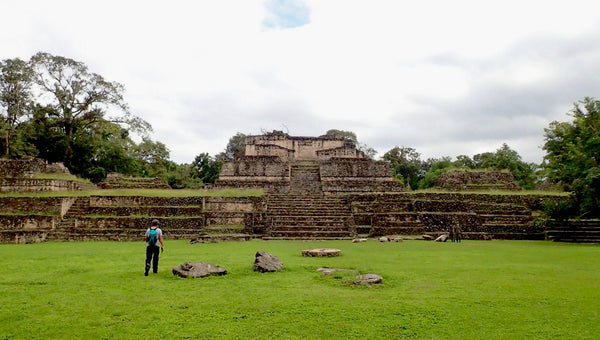
Temple of the Wooden Lintel is one of the oldest structures dating back to the 1st century CE.

The Maya channelized rain water into many aguadas or reservoirs helping to support agriculture and to survive in the dry season. The aguadas are the only water sources at Caracol. Our guide, Luis, informed us that the water lilies were a sign of fertility because without water neither the lily or the Maya could survive.
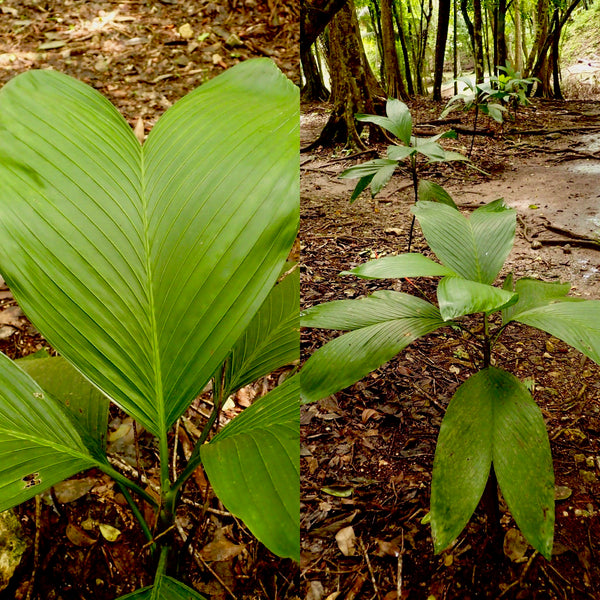
Walking through the jungle surrounded by bird songs and howler monkeys, these Chamaedorea palm species grow on the forest floor. The palms are locally known as xate (shatey). The leaves are used in the floral trade and for Palm Sunday festivities. A perfect leaf is worth one U.S. dollar and can stay fresh for up to 40 days after being cut. Xateros, the leaf collectors, are over harvesting in Guatemala and Mexico. Belize has become a harvesting ground and is one of the reasons the military is keeping watch for looters of both the palms and ruins.

Even as we walk the 97 large stone steps to the top of Caana, we are escorted by our guide and military police. Our guide explains that the top of the 'sky palace' is the best cell phone reception in the area due to it's height of 141 feet. It was also the home of the ruling families.
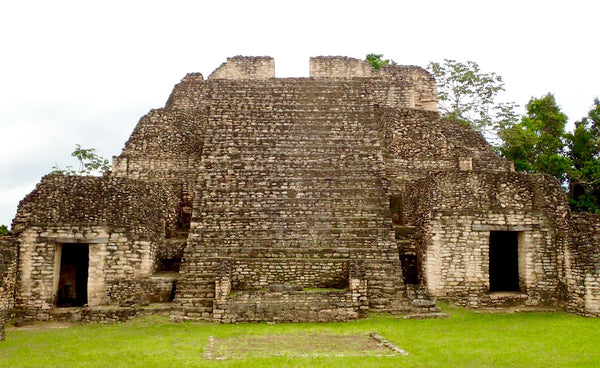
This is the palace near the summit and includes rooms that were once lived in by the ruling families.
Caracol contains many carved monuments, as well as, hundreds of burial tombs that have been excavated explaining the timeline of rulers and events. According to archeologist, Dr. Jaime Awe, "Tombs buried the ancestors. Buildings above the tombs were a living entity to the Maya because they were able to keep the spirits of the ancestors as part of the family and they could petition the ancestors as intermediaries with the departed, as well as, the Gods." Most of the visible unearthed ruins were constructed in the Late Classic period on top of prehistoric buildings.

Ruins on top of ruins built on top of prehistoric buildings covered by jungle.
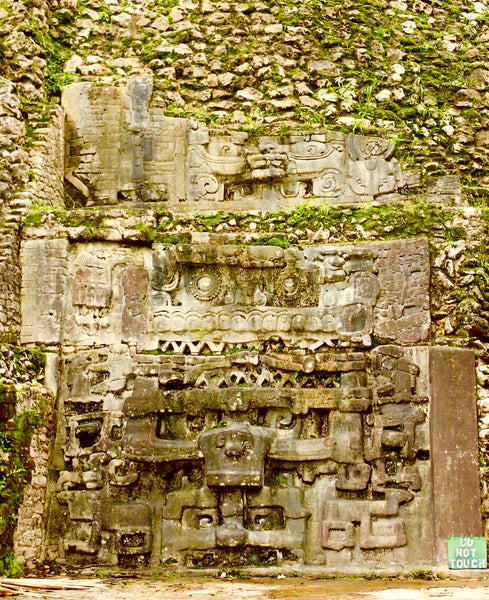
Stone carving of the Water Lily Jaguar. Click here to watch a 4 minute video of Dr. Jaime Awe explaining how archeologists uncovered this stone monument while choosing to destroy the architecture above. Dr. Awe is quite charming and charismatic. Video by Julie Schwietert Collazo

Tomb of a ruling ancestor
An unburied child was found in the palace at the summit of the Caana. This discovery leads archeologists to believe initial abandonment of the site was hurried, along with, fire damage in several of the excavated Late Classic buildings. Both war and drought are possible factors to the final abandonment of Caracol around 1050 CE.
As we finished the nearly 2 hour tour, we offered our sincere thanks and appreciation to our tour guide. Luis was well versed in the Maya history and eagerly described the plants of the rain forest for The Botanical Journey. While we drove away, we also said a prayer to our own ancestors and left before the next military escort. (I know, but it worked.)
For more information about Caracol:
Book a guided tour to ensure entrance. Tours can be found throughout the country. Ask hotels or local guide companies. Trips usually include other fun stops like hiking to waterfalls, caves, or swimming in rivers.
The Belize Institute of Archeology, http://www.nichbelize.org, Caracol
To view a complete tour of the site with Belize archeologist Dr. Jaime Awe click here. After watching this video, I am excited to revisit the site. This is also the source for the above quote about burial tombs and the ancestors by Dr. Awe
To read the New York Times article, Mapping Ancient Civilization, in a Matter of Days, about the lidar findings in 2009, click here
Click Belize to read more of The Botanical Journey's articles including other Maya ruins

1 comment
I dated Barry Bowen when I was living in Belize with my mother 1960-61 and 62 and Barry and I went there to that Mayan ruin before it was being worked and it was an amazing event. I was 14 or 15 and he was 15 or 16 years old and drove all over the place and that jungle